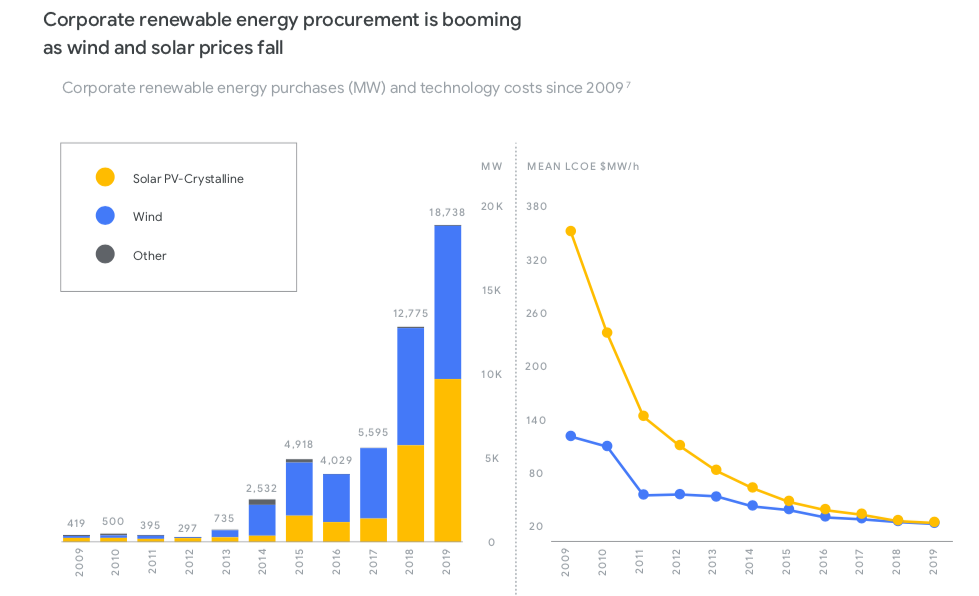The opportunity for technologists and entrepreneurs from 24/7 Carbon-Free Energy, the most compelling strategy yet to apply the power of the private sector to decarbonize the grid

24/7 Carbon-Free Energy, also known as 24/7 Carbon-Free Electricity or CFE, is a strategy to use the power of the private sector to decarbonize our power grid, and it is a good one. It will need a whole new set of tools to track and purchase energy, essentially creating a metadata layer for all energy generation, distribution and consumption. So what’s to like about 24/7 CFE and what opportunities does it present for technologists?
The problem(s) with Net-Zero
With more companies rushing to announce Net-Zero targets, it’s worth taking a closer look at one of the reasons why Net-Zero falls short as a pathway to decarbonization. You might first suspect that this is somehow related to how companies can use carbon offsets to “cancel” their emissions, and you would be right. But even if we look past offsets to examine a hypothetical model company that has used Power Purchase Agreements (PPAs) with bundled RECs to source 100% of its electricity from renewable sources, we would find that it remains reliant on electricity from fossil-fuel sources. Why is this? It’s because current PPAs are structured around annual or monthly aggregated energy delivery but make no attempt to match the time of generation with the time the electricity is needed by the company. The way current PPAs are structured, it’s like signing up for a CSA only to receive one 100lb crate of vegetables on your doorstep.
So how mismatched is renewable generation from typical corporate consumption today? A study released last week by the Princeton Zero Lab, and funded by Google, found that a PPA covering 100% of Google’s annual electricity consumption with renewable generation achieves only 75% carbon-free energy when connected to the California grid. If connected to the PJM grid in the Eastern US, that number drops to 62%.
And that’s because the value of carbon-free energy varies by the time of day and location it is generated, but the locational and temporal value of this energy is not currently acknowledged in the energy ecosystem. Because this data is missing, it’s the economics for renewable developers that dictate the type of renewable resources that get built, not the actual energy need or carbon emissions displacement potential during a given time of day. Wind will peak in the early evening and solar will peak midday, but that energy will not be well matched to the time that energy is actually needed on the grid, especially in places like California that already have a high base of variable renewable generation. It’s worth repeating that today, no company can procure 100% of its energy from external carbon-free sources without intense manual effort, time and expense, assuming it is possible at all.
Enter 24/7 Carbon-Free Energy
24/7 Carbon-Free Energy (CFE) is a strategy that changes this dynamic. When a company adopts the goal of sourcing 100% of its energy from nearby carbon-free sources, it matches its procurement of clean energy with its energy use hour-by-hour and location-by-location. By adopting a 24/7 CFE goal, a company encourages the development of generation and storage resources that deliver energy when and where it is actually needed, increasing the cost-efficiency and optimizing the deployment of clean generation and storage technologies in each local grid. It is a local-optimization strategy for decarbonization that is suited to independent corporate actors, and doesn’t rely on or adversely affect a systems-optimization strategy that could be executed by a grid managing authority. 24/7 CFE drives positive system effects as well, by supporting investment that will lower the cost of clean firm and storage technologies. The Princeton team found that if 10% of Commercial and Industrial firms reach 24/7 CFE, we would see 1.9-2.3GW of clean firm generation and long-duration storage capacity deployed in California and 5.9-7.1GW in PJM by 2030. Google and Microsoft are among 40 companies that have put support behind 24/7 CFE through the 24/7 Carbon Free Energy Compact.
How 24/7 CFE becomes reality
So what prevents companies from achieving 24/7 CFE immediately? It’s mainly down to the cost of energy storage (and firm CFE energy), the capture and accessibility of information in the energy ecosystem, and the need for new marketplaces. Paraphrasing Saul Griffith, decarbonization is a social and engineering problem. It is within reach if we focus our attention on it.
There is no Moore’s law for clean energy, but the learning rate is about the closest thing. The learning rate describes the reduction in cost when production is doubled. We’ve seen this in action with solar, where over the last ten years, the cost of utility-scale solar generation dropped 82% as renewable portfolio standards stimulated production. Batteries have a learning rate between 26-30% and NREL has modeled significant future price declines as we increase demand via EVs and utility-scale storage.
[Source: NREL, Cost Projections for Utility-Scale Battery Storage: 2021 Update]
The accessibility of data is set to improve too, since regardless of what strategies we use to decarbonize the grid, data on the carbon value of generation will be necessary to prioritize additive clean generation and storage, rather than new renewable generation that does little to displace fossil fuel generation. We will want to address the data accessibility problem regardless of whether 24/7 CFE catches on, but it provides one more incentive to accelerate the availability of solutions.
Regarding new marketplaces, the past few years have seen a marked increase in corporations ramping up their procurement of energy from third parties. And make no mistake, it’s independent power producers, not utilities, that are responsible for most of new renewables development over the last ten years.
Figure: Growing Number of Corporate Purchasers of 3rd-Party Renewable Energy [Source: CEBA, State of the Market 2021]
But executing these deals necessitates legal expertise and challenging, manual search costs, which excludes all but the largest or most dedicated companies. Today this is the domain of companies positioning themselves as Energy-as-a-Service providers, but we can expect to do better. What does a marketplace look like that makes procuring clean energy as simple as any other business service?
So you see that the technical hurdles to 24/7 CFE are not particularly daunting. The question then is why corporates would take on the challenge of 24/7 CFE. Beyond the outliers – there will always be companies that forge ahead, just as there will always be intransigents – this comes down to public sentiment. Just this month at COP26, we saw many of the largest companies in the financial sector announce a new alliance to deploy over $100T of capital for decarbonization – regardless of what this accomplishes, take it as another data point that the private sector has read the tea leaves and wants to be seen as being on the right side of the problem. So what happens when the public understands that Net-Zero is not enough?
A summary of what's needed and opportunities for new solutions
I’ll leave you with a quick and very incomplete survey of what’s needed to make 24/7 CFE feasible in the near future (in a addition to cheaper energy storage):
- As the public gains more understanding that Net-Zero is not sufficient for decarbonization, consumers, shareholders and the finance sector must apply pressure on corporations to go beyond Net-Zero to 24/7 CFE. Beyond increasing awareness and public sentiment, this involves updated ESG ratings for investors, new standards and tools for estimating carbon emissions under the GHG Protocol, and corporate leaders such as Google influencing other companies via organizations such as RE100 and the 24/7 Carbon-Free Energy Compact.
- Most corporations don’t know their hourly energy consumption needs. Penetration of building energy management systems (BEMs) that track detailed energy use is low (possibly single digit low), but NREL just completed an exhaustive data modeling effort and are sharing 350,000 building energy use model archetypes which can form the basis for new tools that can be built to help any company estimate its hourly energy usage. Meanwhile, cheaper and smarter metering equipment with more accessible software systems such as Infogrid.io will provide more companies with better actual data while services such as WithTheGrid can do the same for grid and asset operators.
- We need timely accessible data about generation and carbon emissions, which is becoming available for some grids through new API services such as Watttime and REsurety, but is nonexistent for certain grids, making planning for displacement of fossil generation difficult. New data capture and modeling aims to change that. See EnergyTag, ElectricityMap, WattCarbon.
- Renewables developers, operators and their financiers and insurers will need better data and software for modeling hourly generation performance and underdelivery risk, from siting suitability and performance prediction to monitoring and accounting. Buyers will need better solutions to track the ROI of their energy portfolios. See Aurora Solar, Kevala, Cleartrace, Envizi, Solytic, etc.
- Third-party energy procurement is challenging, and not even allowed in six states. Complexity and manual custom contracting dissuade all but the most committed companies. Vehicles to aggregate demand from smaller companies do not yet exist. It looks like we need a new marketplace. Any takers?
Resources:
24/7 Carbon Free Energy, Google: link.
An excellent analysis of 24/7 CFE by DrVolts, David Roberts: link.
Discussion of policy impacts of 24/7 CFE with participants from Google, RMI and others: link.
A report on corporate energy procurement by Deloitte: link.
Corporate energy procurement state by state by RILA: link.
On learning curves, Oxford Energy: link.
Interested in hearing more? Read this post about the software opportunity in climate tech. Then subscribe and follow @greenwashalert

